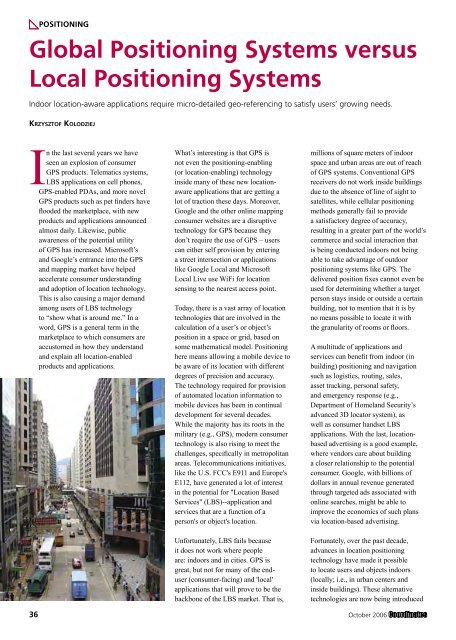It is a time to talk about Asian satellite navigation ... - Coordinates
It is a time to talk about Asian satellite navigation ... - Coordinates
It is a time to talk about Asian satellite navigation ... - Coordinates
You also want an ePaper? Increase the reach of your titles
YUMPU automatically turns print PDFs into web optimized ePapers that Google loves.
POSITIONING<br />
Global Positioning Systems versus<br />
Local Positioning Systems<br />
Indoor location-aware applications require micro-detailed geo-referencing <strong>to</strong> sat<strong>is</strong>fy users’ growing needs.<br />
KRZYSZTOF KOLODZIEJ<br />
In the last several years we have<br />
seen an explosion of consumer<br />
GPS products. Telematics systems,<br />
LBS applications on cell phones,<br />
GPS-enabled PDAs, and more novel<br />
GPS products such as pet finders have<br />
flooded the marketplace, with new<br />
products and applications announced<br />
almost daily. Likew<strong>is</strong>e, public<br />
awareness of the potential utility<br />
of GPS has increased. Microsoft’s<br />
and Google’s entrance in<strong>to</strong> the GPS<br />
and mapping market have helped<br />
accelerate consumer understanding<br />
and adoption of location technology.<br />
Th<strong>is</strong> <strong>is</strong> also causing a major demand<br />
among users of LBS technology<br />
<strong>to</strong> “show what <strong>is</strong> around me.” In a<br />
word, GPS <strong>is</strong> a general term in the<br />
marketplace <strong>to</strong> which consumers are<br />
accus<strong>to</strong>med in how they understand<br />
and explain all location-enabled<br />
products and applications.<br />
What’s interesting <strong>is</strong> that GPS <strong>is</strong><br />
not even the positioning-enabling<br />
(or location-enabling) technology<br />
inside many of these new locationaware<br />
applications that are getting a<br />
lot of traction these days. Moreover,<br />
Google and the other online mapping<br />
consumer websites are a d<strong>is</strong>ruptive<br />
technology for GPS because they<br />
don’t require the use of GPS – users<br />
can either self prov<strong>is</strong>ion by entering<br />
a street intersection or applications<br />
like Google Local and Microsoft<br />
Local Live use WiFi for location<br />
sensing <strong>to</strong> the nearest access point.<br />
Today, there <strong>is</strong> a vast array of location<br />
technologies that are involved in the<br />
calculation of a user’s or object’s<br />
position in a space or grid, based on<br />
some mathematical model. Positioning<br />
here means allowing a mobile device <strong>to</strong><br />
be aware of its location with different<br />
degrees of prec<strong>is</strong>ion and accuracy.<br />
The technology required for prov<strong>is</strong>ion<br />
of au<strong>to</strong>mated location information <strong>to</strong><br />
mobile devices has been in continual<br />
development for several decades.<br />
While the majority has its roots in the<br />
military (e.g., GPS), modern consumer<br />
technology <strong>is</strong> also r<strong>is</strong>ing <strong>to</strong> meet the<br />
challenges, specifically in metropolitan<br />
areas. Telecommunications initiatives,<br />
like the U.S. FCC's E911 and Europe's<br />
E112, have generated a lot of interest<br />
in the potential for "Location Based<br />
Services" (LBS)--application and<br />
services that are a function of a<br />
person's or object's location.<br />
Unfortunately, LBS fails because<br />
it does not work where people<br />
are: indoors and in cities. GPS <strong>is</strong><br />
great, but not for many of the enduser<br />
(consumer-facing) and 'local'<br />
applications that will prove <strong>to</strong> be the<br />
backbone of the LBS market. That <strong>is</strong>,<br />
millions of square meters of indoor<br />
space and urban areas are out of reach<br />
of GPS systems. Conventional GPS<br />
receivers do not work inside buildings<br />
due <strong>to</strong> the absence of line of sight <strong>to</strong><br />
<strong>satellite</strong>s, while cellular positioning<br />
methods generally fail <strong>to</strong> provide<br />
a sat<strong>is</strong>fac<strong>to</strong>ry degree of accuracy,<br />
resulting in a greater part of the world’s<br />
commerce and social interaction that<br />
<strong>is</strong> being conducted indoors not being<br />
able <strong>to</strong> take advantage of outdoor<br />
positioning systems like GPS. The<br />
delivered position fixes cannot even be<br />
used for determining whether a target<br />
person stays inside or outside a certain<br />
building, not <strong>to</strong> mention that it <strong>is</strong> by<br />
no means possible <strong>to</strong> locate it with<br />
the granularity of rooms or floors.<br />
A multitude of applications and<br />
services can benefit from indoor (in<br />
building) positioning and <strong>navigation</strong><br />
such as log<strong>is</strong>tics, routing, sales,<br />
asset tracking, personal safety,<br />
and emergency response (e.g.,<br />
Department of Homeland Security’s<br />
advanced 3D loca<strong>to</strong>r system), as<br />
well as consumer handset LBS<br />
applications. With the last, locationbased<br />
advert<strong>is</strong>ing <strong>is</strong> a good example,<br />
where vendors care <strong>about</strong> building<br />
a closer relationship <strong>to</strong> the potential<br />
consumer. Google, with billions of<br />
dollars in annual revenue generated<br />
through targeted ads associated with<br />
online searches, might be able <strong>to</strong><br />
improve the economics of such plans<br />
via location-based advert<strong>is</strong>ing.<br />
Fortunately, over the past decade,<br />
advances in location positioning<br />
technology have made it possible<br />
<strong>to</strong> locate users and objects indoors<br />
(locally; i.e., in urban centers and<br />
inside buildings). These alternative<br />
technologies are now being introduced<br />
36 Oc<strong>to</strong>ber 2006

















